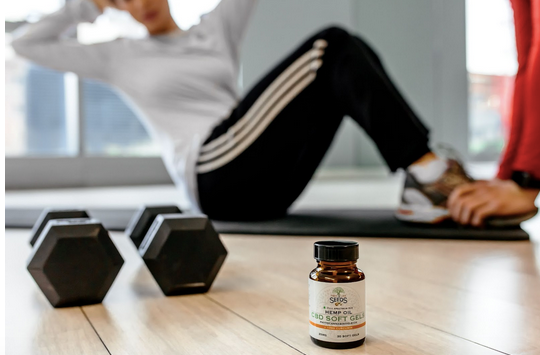How to Safely Return to Fitness After an Injury?
Suffering an injury can be a challenging setback, especially for fitness enthusiasts. It often requires a pause on activities we enjoy and a concerted effort towards recovery. After what can feel like an eternity, the doctor gives the green light to ease back into exercise, and suddenly, the excitement of resuming your fitness journey is mixed with fear and uncertainty. The simple act of setting foot back in the gym or resuming your running routine can be daunting. However, returning to fitness can be a smooth and rewarding experience with the right approach.

Understanding Your Injury and Recovery
Before diving back into your favorite workout, it's crucial to fully understand the nature of your injury and how it's healing. Whether it was a stress fracture, a muscle strain, or a ligament tear, each injury comes with its timeline for recovery. Take the time to do some research or ask your doctor for detailed information about:
- The specific tissues affected
- The healing process and stages
- Signs that you may be pushing too hard
Understanding these details will set realistic expectations and help you make informed decisions as you exercise again. If your injury was caused by the negligence of another, being compensated can help you recover faster. This is because you will have the means to seek medical care and physical therapy. In this case, reputable personal injury lawyers suggest taking legal action to hold the responsible party accountable and receive just compensation. By doing so, you can focus on recovery without financial strain.
Consulting Professionals for a Personalized Plan
Returning to fitness should never be a one-size-fits-all endeavor. It's vital to consult with both your doctor and a fitness professional—like a personal trainer or physical therapist—who can create a program tailored to your body's specific needs. A personalized plan will begin with gentle exercises targeting the injured area, gradually moving on to full-body workouts as you regain strength and mobility.
Eagerness to resume your pre-injury workout routine should be met with patience. Start with very low-intensity workouts that are much lighter and shorter than you were accustomed to. This could mean a 20-minute walk instead of a 10K run or a series of light resistance training exercises instead of a heavy lifting session. The key is to increase the intensity, duration, and complexity of your workouts gradually and incrementally, giving your body time to readjust and strengthen.
Embracing Cross-training
A beautifully varied fitness routine keeps things exciting and reduces re-injury risk. Engage in cross-training, which emphasizes different muscle groups and incorporates a variety of exercises, to maintain overall fitness without overtaxing any one body part. For example, if you're a runner, sprinkle in some swimming or cycling to reduce the impact on your recovering leg muscles.
Your body has an incredible way of letting you know what it needs. Listen to the signals it's sending you. Pay attention to how your injured area feels during and after a workout and any discomfort or pain that may be present. While some discomfort can be expected as you gradually challenge your body, sharp pain is a sign that you're doing too much. Be prepared to adapt your exercise program on the fly to accommodate any discomfort or new limits.
Focusing on Nutrition and Hydration
Proper nutrition and hydration play an enormous role in the healing process. You must fuel your body with the necessary nutrients to rebuild tissue and strengthen your muscles. A diet rich in lean proteins, healthy fats, and fruits and vegetables will support your recovery. Hydration is equally important. Aim to drink plenty of water throughout the day, maintaining a consistent hydration level.
Patience and a Positive Mindset
Returning to fitness is as much about the mind as the body. Patience is key. It's natural to have days when you feel frustrated with your progress, but maintaining a positive mindset can make a difference. Celebrate each small win and milestone on your journey back to full strength and mobility. Remember, every step forward is progress, and with time and consistency, you'll be back to your pre-injury fitness level. Keep pushing on! Moving forward is how we grow stronger.
Ensuring Proper Rest and Recovery
Your body heals and grows stronger during rest. Don't be tempted to overdo it, and schedule regular rest days into your workout routine. Active recovery, such as gentle stretching, yoga, or a leisurely bike ride, can also help maintain fitness on days you're not pushing hard. Adequate sleep is also crucial for recovery. Aim for at least 7-8 hours of quality rest each night.
Avoiding Previous Mistakes
Reflect on what may have led to your initial injury. Whether it was poor form, overtraining, or neglecting a proper warm-up, take steps to avoid making the same mistakes this time. Work with your fitness professional to correct any form issues, stick to your personalized plan, and be vigilant about warming up and cooling down before and after each workout. By learning from past mistakes, you can prevent future injuries and continue your fitness journey safely.
Monitoring Your Progress
Keep a journal of your daily workouts and how you're feeling physically. This will provide you with a record of your progress and any patterns you notice regarding your recovery. Additionally, consider using wearable fitness technology to track your activity levels and see how well you adhere to your personalized plan. Knowing your progress can motivate and inspire you to keep moving forward.
Celebrating Every Milestone
Embarking on a fitness journey after an injury is a victory in itself. Each step forward, whether an increased workout duration or a heightened level of a particular exercise, is a reason to celebrate. Setting and achieving short-term goals will keep you motivated and focused on your progress. Before you know it, you'll return to your pre-injury fitness level and be ready for new challenges.

Returning to fitness after an injury is not a race but a journey. It requires careful planning, a patient approach, and a commitment to your well-being. With this comprehensive guide to help you navigate your comeback, you can turn a challenging moment into an opportunity for new growth and a deeper connection to your body. Remember, safety is paramount—there's no need to rush. Take your time and enjoy the process of rebuilding yourself stronger than ever.